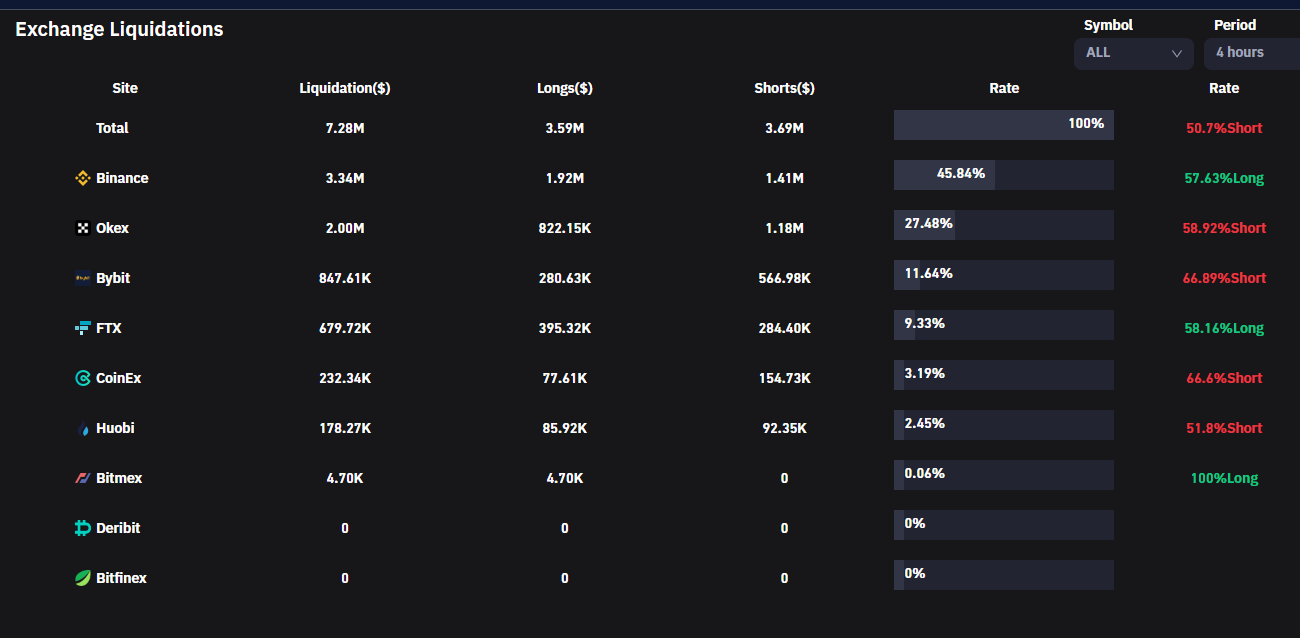How the Crypto Market Will Survive the Wave of Liquidations
How the Crypto Market Will Survive the Wave of LiquidationsATZCrypto - Latest Bitcoin, Ethereum, Crypto News & Price Analysis Traders have been affected by massive liquidations over the past few months, with BTC and the crypto market experiencing the...

Traders in the cryptocurrency market are taking heavy hits, with more than 180,000 seeing their positions liquidated, and Bitcoin is the most affected. After signs of breaking out from the bearish market, the crypto market continues to take blow after blow as hundreds of millions of dollars vanish in liquidation.
Saying that the crypto winter is over may be premature, even as Bitcoin price and Ethereum prices slump south. Most recent bullish rally was brief but the positive price movement caused investors and traders to liquidate their short positions.
Institutions attempt to ward off liquidation.
Celsius cryptocurrency lender added more BTC on decentralized finance platform, MakerDAO. In doing so, the network lowered the price for liquidating its position. The lender had suspended withdrawals following the extreme liquidity crunch. According to on-chain data, if Bitcoin price had hit $16,852, then Celsius’ $522 million position would have been liquidated. Celsius liquidation would see the lender forced to sell its position and dump all its BTC in the open market. A sale to this extent would be detrimental to Bitcoin prices.
However, Celsius avoided the outcome by adding collateral to avoid liquidation. The lender added Bitcoin to its position, a move contingent upon BTC remaining above the liquidation price. Celsius would have faced bankruptcy and a total loss of customer funds if this level were breached. Liquidation would also see Bitcoin crash to below $10K.
MicroStrategy was also in the liquidation crossfire following their decision to buy more tokens. The business intelligence company will face a billions of dollars in liquidation if the BTC price crumples.
Liquidation statistics
The recent rally in Bitcoin and Ethereum triggered the liquidation of many short positions. This brought the total liquidated shorts to approximately $160 million and long positions to around $90 million, totaling $250 million in liquidations.

Liquidation data on Coinglass shows that over the last 24 hours, up to 81,172 traders were liquidated, bringing the total liquidations to $189.24 million. Per the report, Bybit recorded the largest single liquidation order- BTCUSDT value of $1.17M.
Exchange liquidations

Bitcoin has dropped to approximately $22,859.00, Ethereum to $1,585.98, while most Altcoins are suffering double-digit drops. From all these liquidations, more than $68.99M was Ethereum liquidations, while Bitcoin records over $30.77M. Among the other big losers are ETC, recording more than $11.24M in liquidation. Another was FIL, with over $9.02M at press time. Most of these liquidations are due to short positions.

Almost 70% of traders in the crypto market that went long lost their positions. Most of them (up to 60%) are on either Binance or OKX. Even by the market’s current standards, 180,358 traders being liquidated is still a significant number. Most people did not expect BTC to go further south, which explains why most investors were shaken.
The total market capitalization at the time of this writing is $1.09 on CoinGecko, down by 3.3% over the past 24 hours. This is among the biggest drops the market has seen, with the likes of Fantom, Axie Infinity, Waves, and Nexo suffering the most.
It remains a difficult time for the crypto market, which has only started to recover. The turnout is even worse as the industry has advanced in infrastructure, development, and regulation. However, the developments are not reflected in numbers.
As Q4 approaches, analysts suggest that the rest of the year will become a pivotal period regarding where the market may go in the short-term future. Nonetheless, this could go either way, as the crypto market has a history of retracting swiftly from such circumstances.
Massive liquidations affect traders.
Massive liquidations have affected traders over the past few months. BTC and the crypto market experience the heaviest price drops over the past three months. In May 2022, for instance, liquidations reached $500 million and $260 million before that in April. Nonetheless, the market had seen even leaner times, such as October 2021, when the Bitcoin price dip resulted in over $900 million in liquidations within 24 hours.
There remain varying opinions on how this will affect the crypto market in the foreseeable future. While some are concerned that this much liquidation will slow down the growth of the industry, others continue to manifest that typical HODL spirit and are worried about these long drops.
Prominent personalities are among those holding that mandate, with Michal Saylor leading the group. According to the MicroStrategy CEO, he has zero fears of another crypto winter.
Why liquidation spells doom for the crypto market
The risk of mass liquidation remains among the biggest threats right now, with the potential to cause a very severe flash crash in the crypto market. If the liquidation wave prevails, billions of dollars in crypto could be sold into extremely weak markets unless more security is posted.
Earlier in 2022, the cryptocurrency market witnessed a massive crash because of the economic strain presented by the pandemic. Although Covid-19 affected most people, the crypto market benefitted from a “stress test.”
The test helped to emphasize the notion that Bitcoin and crypto markets are not just necessary but also enduring, just like fiat currencies. In addition, the test also taught crypto users about other dynamics of the market. One such revelation is that from a borrower’s standpoint, the recent crash proved why it is advisable to deal only with reliable exchanges.
Lenders use interest from held cryptocurrencies to fund more loans. Because of such structures, the mode of operation for most responsible crypto lenders is to protect the borrower and the interest earned. In so doing, they achieve a healthy working market.
In this scheme, lenders are afraid to liquidate assets because it weakens the parameters of their lending stronghold. This reduces the idea of what sustains crypto lending platforms- the cyclic, lend, earn, loan structure.
Nonetheless, it is the responsibility of lenders to protect their entire customer base and the market at large. In case of a market dip, liquidations must take place to protect the infrastructure of borrowers and the business.
How lenders protect clients
Responsible crypto lending institutions will often tell their clients the point at which liquidations occur in a market drop. Although liquidation may not be the only reasonable reaction to a massive market drop, most lending institutions will provide their clients with the ability to pay off part of their loans. The lenders may also add more assets as security to compensate for the dip before liquidation.
However, in cases where such contingencies are unavailable to borrowers, lenders must liquidate. If the lender fails to liquidate, the borrower has no incentive to maintain their payment scheme; neither can they refresh their assets during an extreme downturn.
At this point, liquidations become crucial and utterly necessary within the crypto ecosystem. They keep the complete lending network from becoming obsolete in a market downturn. Liquidation has become the insurance policy against non-payment. As such, while no platform wants to be where they need liquidation, it is motivating to understand that liquidations will occur when necessary. It helps to make the exchange more stable.
As much as liquidations are detrimental to BTC owners and lenders, the benefit of this liquidation to the entire crypto market is worth the pain of loss. The offerings would include lenders and borrowers alike.
How the Crypto Market Will Survive the Wave of Liquidations
While lenders and borrowers are afraid of liquidations, this unwanted scenario could be the key to helping the global market. When it comes to lending, crypto players rarely think about collective concepts. Fiduciary conversations will often take a binary approach with such a stance; both the lenders’ and borrowers’ interests matter.
Crypto lenders must now forced to rethink and expand their scope. They now have to concentrate less on individual benefits and consider the health of the entire market. Rather than limiting their attention to their bottom line, they must make difficult decisions to protect a whole economic infrastructure.
Delegate Your Voting Power to FEED DRep in Cardano Governance.
DRep ID: drep12ukt4ctzmtf6l5rj76cddgf3dvuy0lfz7uky08jfvgr9ugaapz4 | We are driven to register as a DRep by our deep dedication to the Cardano ecosystem and our aspiration to take an active role in its development, ensuring that its progress stays true to the principles of decentralization, security, and community empowerment.DELEGATE VOTING POWER!








